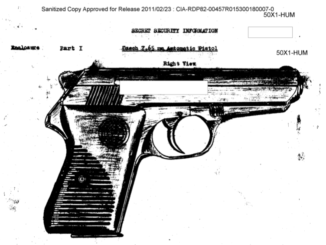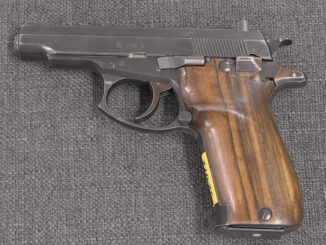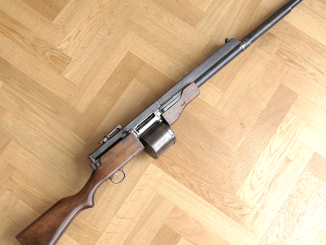Yesterday we looked at the history and the mechanics of the Czech UK vz.59 universal machine gun – so today we are taking it out to the range for some shooting!
The UK 59 is a belt fed, 7.62x54R machine gun, capable of only fully automatic fire (it has no semiauto selector). It is unusual in using a push-through belt with a rimmed cartridge, but that system works just fine here. Belts were available in 50-, 100-, and 250-round lengths along with belt boxes to attach the ammunition to the gun (which I did not have available).
Overall, I found the vz.59 to be a rather difficult weapon to shoot effectively. Whether it is the gun’s weight, the bolt velocity, rate of fire, or just something about its harmonics, the gun vibrates significantly when firing and it is difficult to maintain a sight picture or situational awareness when firing. It certainly is a light and sleek weapon, though. I suspect that as a semiauto conversion (currently available in the US through MarColMar) it would be much nicer to use.
Thanks to Marstar for letting me examine and shoot their UK vz.59!




If it can be shot from left shoulder, it must be “universal” 🙂
I completely agree with Ian’s conclusion – if Czechs were left with their universal 7.62×45 cartridge, it may be a viable project; even these days, given some modernisation. The 7.62R is too much for such ‘light’ weapon.
One interesting item to observe, part of smart strip forward system, is how wildly the belt whips around. This is due pay for single stage feed; PKM and even Negev are not any different in that regard. But yet, there are no malfunctions to feed.
I agree. Why not just leave Czechs alone and save Moscow a whole ton of Rubles?
I question, to this day, why Soviets allowed Czechs to develop their own small arms and even artillery. None of other allied states were either ambitious enough to do so, or more likely, did not have that capacity. Perhaps Yugoslavia, although not member of WP, tried to stand on their own, but their equipment was a hodgepodge of largely incoherent components.
Only interpretation I can thing of may conclude from two parts. First is that relationship of both countries before 1968 was, unlike with any other, genuinely friendly. Second and more practical might be that Soviets used products of Czech armament industry as a comparable samples to their own. At the end, there was no harm with this, on surface ‘duplicity’. Gained tradition and experience propped current Czech small arms industry to maintain its viability and even some limited international sales success.
“Yugoslavia”
Yugoslavia even (attempted) procurement of own design of tank, namely Tenk Tip-A
http://www.tanks-encyclopedia.com/coldwar/Yugoslavia/tenk-tip-a
T-34 inspiration is clear, interestingly this tank was produced without making blueprints (do not ask me why they made it this way), 5 examples were made which varied greatly due to this, they were plagued with reliability problems and inter-example differences make any “debugging” hard. Finally with getting access to surplus U.S.-made tanks, pressure for making own tank vanished.
“None of other allied states were either ambitious enough to do so, or more likely, did not have that capacity”
Hungary adopted and deployed weapon codenamed K1
http://hungariae.com/KuchK1GP.htm
which was belt-fed full-auto 7,62x54R weapon
And also D-442 FÚG: https://en.wikipedia.org/wiki/D-442_F%C3%9AG
(it is separate design from BRDM-1 with which is sometimes confused)
Recall that Edvard Benesh was trying to acknowledge the great power demands of Stalin’s USSR and including the Czechoslovak CP in the government, armed forces, police, etc. but that Czechoslovakia had some latitude until the “Victorious February” or CP coup in 1948. Until that time, with the large arms factories and industry, as well as a whole bunch of gifted engineers and designers, why not allow the Czechoslovakian arms industry to go its own way for a time?
Recall as well that the Soviet “intermediate power cartridge” was initially 7.62x41mm before being trimmed to its M43 7.62x39mm form. The Czechoslovaks had the 7.5x45mm and then settled on 7.62x45mm before having to toe the Warsaw Pact line and adopt 7.62x25mm instead of 9x19mm, the 7.62x39mm instead of 7.62x45mm, and 7.62x54r instead of 8mm Mauser and so on.
If France was basically outside Nato in all but name, then I suppose Romania might be analogous to the Warsaw Pact, no? I mean the Romanians even disallowed Soviet transit through their national territory… Something the avowedly neutral Swedes had not done to Germany during WWII! Just barely “inside the tent” I guess.
The real oddity–well, at least to me–is that the “broom” or VZ58 didn’t use magazines that were interchangeable with those of the Kalashnikov?
Speaking of CSR, the years between 1945 and 1950 were extremely tumultuous and it reflected well in small arms and other military equipment development. The upshot was that it resulted in short time in fairly large palette of arms, the UK vz.52/57 and later vz.59 being the result.
To bring light some less known facts; president E. Benes was representing National-Socialist party (no relation to German namesake) which was in power, in coalition with others, already before the war. By 1943/44 when it was clear who will have decisive influence in post-war Central Europe, pres. Benes cultivated future relation with USSR, which in fact has become guarantor of territorial integrity of country as was before the war minus Trans-Carpathian Ukraine (without that it might have happened that Sudeten would be attached to Germany since West did not care less).
Communist party of CSR had continuously strong preferences among voters already before the war and in 1946 won over 43% of the vote – most ever. Victory of USSSR in Central and Eastern Europe definitely helped their cause. However, methods they used to grab full power in 1948 rightly deserve criticism. In some way their ascendancy was augmented by radical reforms in ownership of large enterprises by first post-war government which were nationalized immediately and later all enterprises with up to 50 employees. After Communist coup in February 1948 practically all private ownership of means of production, including small businesses ceased to exist.
“None of other allied states were either ambitious enough to do so, or more likely, did not have that capacity.”
Putting all historic-political sentiments aside, you must admit that there is no need to reinvent wheel. Could Warsaw Pact members develop, for example, own counterpart of PK? Technically probably yes. Would it be outperform PK? Maybe, but I doubt it would have enough advantages, to justify spending funds and time to R&D and put it in production (that you have excellent-performing weapon prototype does not mean that putting it into economic production would be easy and effortless).
Though developing own weapon had sense if not weapon of given class was accessible, for example https://modernfirearms.net/en/submachine-guns/poland-submachine-guns/pm-63-eng/
I do not want to underestimate tendencies toward self-sufficiency in armaments in other East-block countries, namely in Poland and Hungary; especially Poles did tremendous strides forward. But also some other countries have shown tendencies in that direction; for instance DDR have worked on their own new ‘sturmgewehr’ which was close to implementation.
Yet, fact of the matter is, that for combination of reasons (one of which might have been that Germans kept Czech armament industry largely in place during occupation and Soviets did not interfere either) it were the Czechs who took the lead. From today’s prospective, and taking into account temporary decline in years 1990-99, they were able to return to their previous proficiency. It suffice to observe popularity of CZ sporting arms in U.S.A; none of other former WP member countries can match it.
Comparing PK and vz.59 is not an easy task and this work must have been done in early years while testing was performed in Soviet Union. The outcome was that while Soviets were full of praise for CZ product, they for easy to understand reasons did not adopt it.
My own view is, that while both carry on with some cleverly thought out features, the PK is slightly ahead. The reason being is the overall balance of purpose and cost; but the margin is small, IMO. The Czech gun is slightly on expense heavy side/ overbuilt. You do not need MG which lasts for million rounds. At the same time the vz.59 exceeded its competitor in method of cartridge feeding – I dare to say – hands down.
“t the same time the vz.59 exceeded its competitor in method of cartridge feeding – I dare to say – hands down.”
PK is compatible with belt for SG and SGM machine guns and due to its construction it can not fed directly. One of competitors to PK had own belt design and direct fed, it was officially rejected due to reliability in wet conditions, however having belt-compatibility with older patterns of machine guns might have effect on decision as well.
” The 7.62R is too much for such ‘light’ weapon.”
Japanese Self-Defense Forces must think similar about brand new 7.62×51 NATO cartridge, which they decided to adopt in weaker-load version along:
https://modernfirearms.net/en/assault-rifles/japan-assault-rifles/tip-64-eng/
I am not sure what would happen if “full” 7.62×51 NATO would be loaded and fired, vice versa (“Japanese” load in “True NATO” weapons) would probably mean weapon would not cycle, but nothing dangerous should happen.
“Czechs were left with their universal 7.62×45 cartridge”
In fact was would become vz. 58, was originally developed in that caliber, among its competitor was ZB-530: https://raigap.livejournal.com/485972.html
(this weapon accept vz. 52 machine gun magazines, it is gas-operated)
This is Rambo-gun; never saw it before. 🙂
Too bad the ZB-530 doesn’t have the infinity-sign-shaped magazine for making Rambo scenes! Guess what I just did there…
With all due respect to the author of this article I completely disagree with his conclusion……I’ve shoot from this gun frequently in 70’s while serving with military.this was smoothest and the most precise gun(for machine gun) I ever shoot from ,all you need to do is to adjust rate of fire ,lovely gun.You guys probably have junk gun with all sorts of mechanical plays.Regards Ivan.
Ian,
Later in the video you scratched your back and the grip touched the ground. It sounded like the bolt slammed forward. I watched that segment several times but could not see if that is what happened. Did it? Also, does driving the rimmed case thru the steel belt ruin the cases and the belt links?
Jim
Part of the problem here is that Ian is evaluating the weapon minus the most important component–the tripod.
You look at a GPMG-class weapon, you really have to look at the whole system, which is going to include the tripod support it is fired off of. The bipod is generally not the primary support these guns are meant to be fired from, and that means you are really only looking at a small wedge of the gun’s performance and characteristics when you do that.
That is very valid point – off bipod use is kind of contingency mode and does not represent centre of focus for(any) GPMG.
The area that became Czechoslovakia and now the Czech Republic was the arms center of the Austrian-Hungarian Empire going back a couple of hundred years. I suspect that had a lot to do with the Soviet Union letting them design small arms since before W W II they had a world wide reputation for quality and reliability.
You probably mean Skoda-werke Pilsen/ Plzen which was oriented towards artillery including large caliber ship and coastal guns. There were no military rifles or machineguns made in Bohemia/ Moravia, now Czech republic, during A-H empire times. Current Slovakia was part of Hungary and had virtually no industrial manufacturing to speak of (but yes, there was ores mining).
“machineguns(…)during A-H empire times”
Actually Škoda produced machine gun: https://en.wikipedia.org/wiki/Salvator-Dormus_M1893
indeed of peculiar design, but nonetheless full-filing all conditions to be considered machine gun (rifle-caliber cartridge and using energy from firing cartridge to cycle)
It was later developed further, see photos here:
http://getwar.ru/avstro-vengerskie-pulemety-skoda-m1893-skoda-m1902-skoda-m1909-i-skoda-m1913.html
First from bottom: Schwarzlose (on tripod) compared to Škoda M1909, other images description are quite self-explanatory. Following model are known to exist
M1893 – original
M1902 – altered feed system (more durable), mounted on tripod with shield (see photo), limited quantity sold to: Romania, Holland, Japan (IJA), never gain popularity due to introduction of Schwarzlose machine gun
M1909 – belt-fed (capacity 250), added cartridge oiler, Rate-of-Fire 425 rpm, Rate-of-Fire regulator deleted
M1913 – slightly improved 1909, differs in sights and production of technology, adopted and produced (used by Austrian-Hungarian reserve troops, limited combat usage)
All were finally replaced by Schwarzlose machine gun
Something for diversion… like if we did not have enough already.
The guy in video is trying to shoot, in hap-hazard manner, UK vz.59 from anti-aircraft mount (or better say ‘antiaircraft setup’ tripod).
https://www.youtube.com/watch?v=N6aH9JkdBt8
I am not sure if he actually known what he is doing. This is what happens when you put dangerous toys to kid’s hands.
“I am not sure if he actually known what he is doing.”
After this description I excepted something more… spectacular?
Maybe something like that: https://patriot-su-rf.ru/photos/20291870896
Also it is advisable to know your weapon to avoid situation like:
https://tanks-a-lot.tumblr.com/post/172110255952
“Something for diversion…”
https://tanks-a-lot.tumblr.com/post/172129085402/captain-price-official-when-you-find-an-obscure
Here is a handy guy who is building and retailing UK vz.59 while implementing some clever changes; although gun is semi only.
https://www.youtube.com/watch?v=79WFwpiB7Fk
I must give him a credit for that.
Silly question? It may be the heavy barrel/bipod or the geometry of the stock but usually full auto full power cartridge rifles climb when fired.
With machine guns like this what factors keep the barrel from climbing?
From video machine guns with billed while they jiggle the sight picture the gun remains level.. what am I missing?
Is anyone aware of a way to put bullets in the belt of this gun other then by hand?
My friends in Ukraine have received one of those from Czechs… and getting belts together is a real pain.